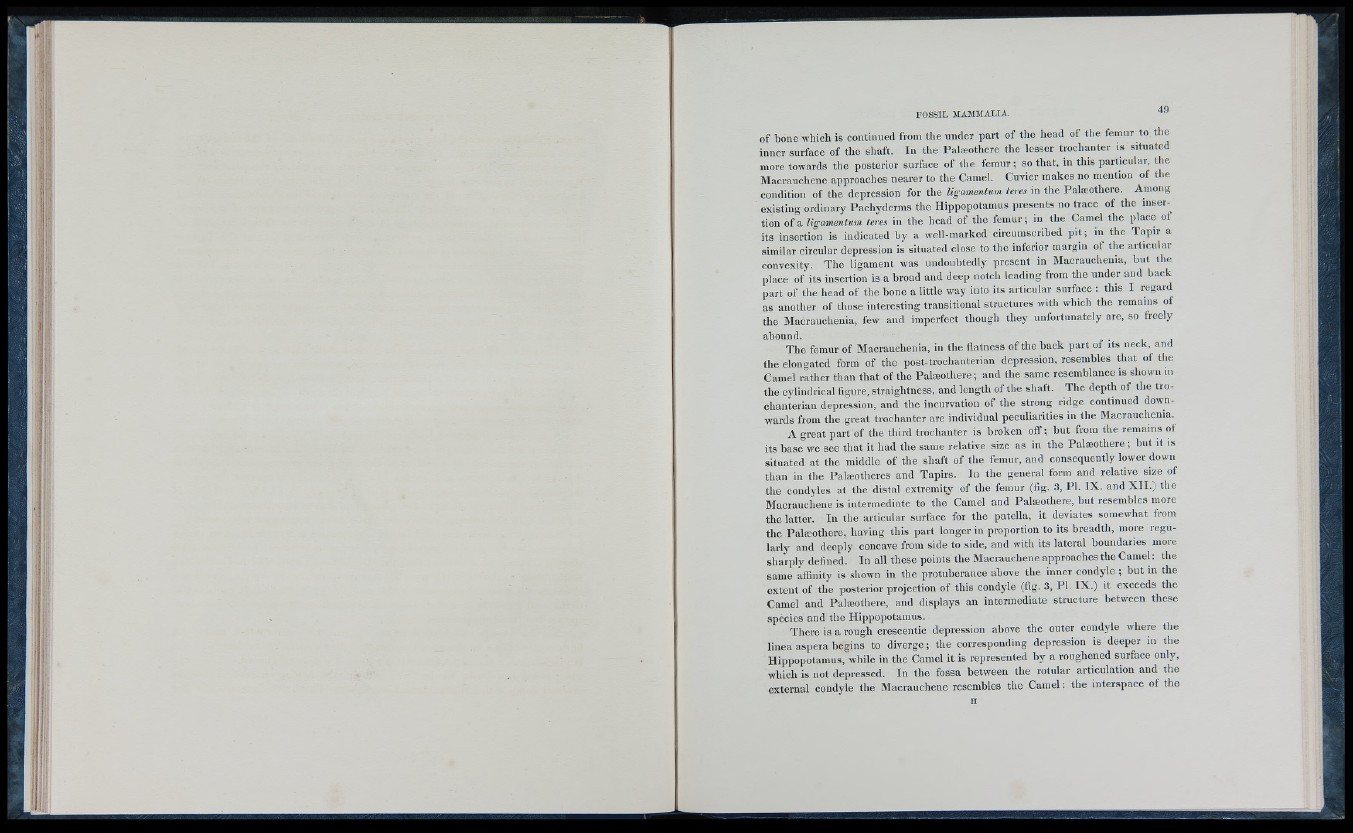
o f bone which is continued from the tinder part o f the head o f the femur to the
inner surface o f the sliaft. In the Palæothere the lesser trochanter is situated
more towards the posterior surface o f the femur ; so that, in this particular, the
Macrauchene approaches nearer to the Camel. Cuvier makes no mention oi the
condition o f the depression for the Ugamentum teres in the Palæothere. Among
ex isting ordinary Pachyderms the Hippopotamus presents no trace o f the insertion
o f a Ugamentum teres in the head o f the femur; in the Camel the place of
its insertion is indicated b y a well-marked circumscribed p it; in the Tapir a
similar circular depression is situated close to the inferior margin o f the articular
convexity. The ligament was undoubtedly present in Macrauchenia, but the
place o f its insertion is a broad and deep notch leading from the under and hack
part o f the head of the hone a little way into its articular surface : this I regard
as another o f those interesting transitional structures with which the remains of
the Macrauchenia, few and imperfect though they unfortunately are, so freely
abound. o • ^ \
Th e femur o f Macrauchenia, in the flatness o f the ba ck part o f its neck, and
the elongated form o f the post-trochanterian depression, resembles that o f the
Camel rather than that o f the Palæothere; and the same resemblance is shown in
the cylindrical figure, straightness, and leng th o f the shaft. T he depth ot the tro-
chanterian depression, and the incurvation o f the strong ridge continued downwards
from the great trochanter are individual peculiarities in the Macrauchenia.
A great part o f the third trochanter is broken o ff; but from the remains ot
its base we se e that it had the same relative size as in the Palæothere ; but it is
situated at the middle o f the shaft o f the femur, and consequently lower down
than in the Palæotheres and Tapirs. In the general form and relative size o f
the condyles at the distal extremity o f the femur (fig. 3, PI. IX . and X I I .) the
Macrauchene is intermediate to the Camel and Palæothere, hut resembles more
the latter. In the articular surface for the patella, it deviates somewhat from
the Palæothere, having this part longer in proportion to its breadth, more regularly
and deeply concave from side to side, and with its lateral boundaries more
sharply defined. In all these points the Macrauchene approaches the Camel : the
same affinity is shown in the protuberance above the inner condyle ; but in the
ex tent o f the posterior projection o f this condyle (fig. 3, PI. IX .) it ex c eed s the
Camel and Palæothere, and displays an intermediate structure between th ese
spe cie s and the Hippopotamus.
There is a rough crescentic depression above the outer condyle where the
linea aspera begins to diverge ; the corresponding depression is deeper m the
Hippopotamus, while in the Camel it is represented by a roughened surface only,
which is not depressed. In the fossa between the rotiilar articulation and the
external condyle the Macrauchene resembles the Camel : the interspace o f the